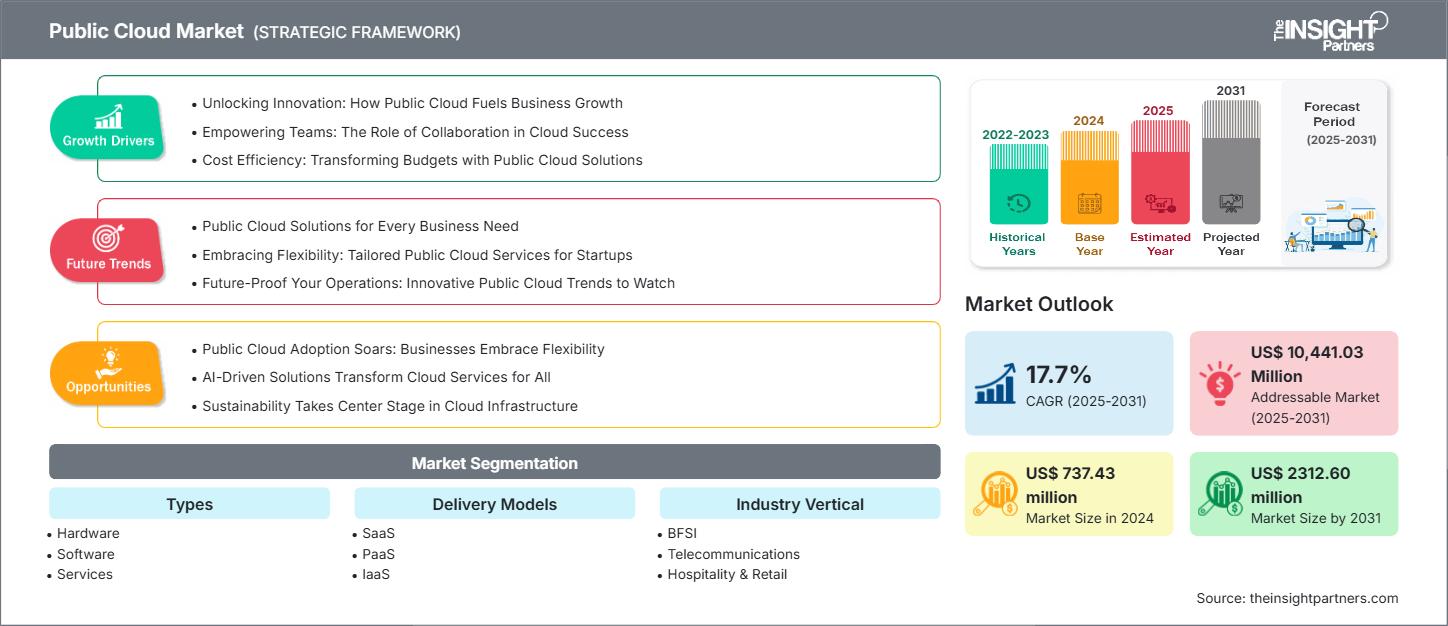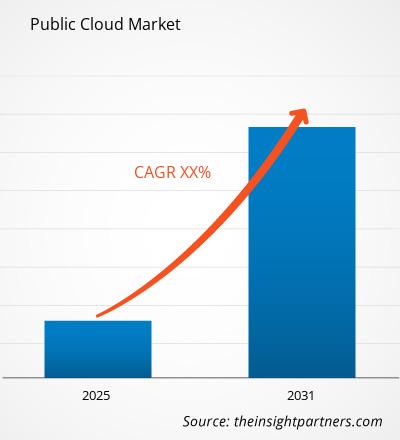Public Cloud Market Growth, Trends, and Analysis by 2031
Historic Data: 2021-2023 | Base Year: 2024 | Forecast Period: 2025-2031Coverage: Public Cloud Market covers analysis by Types, Delivery Models, and Industry Vertical, and Geography (North America, Europe, Asia Pacific, and South and Central America)
- Report Date : Feb 2026
- Report Code : TIPTE100000170
- Category : Technology, Media and Telecommunications
- Status : Upcoming
- Available Report Formats :


- No. of Pages : 150
The Public Cloud Market size is expected to reach US$ 684.47 Billion by 2031. The market is anticipated to register a CAGR of 14.8% during 2025-2031.
Cloud services act as the storage or third party vendors where the data of organization is stored for various purposes. The stored data is then retrieved for analytical purposes. The public cloud domain denotes, the cloud services offered over a public network that can be accessed remotely. The biggest advantage of having the public cloud model is that organizations will have limited concerns regarding the storage and maintenance of data. The setup is off-premise and the architecture type is multi-tenant where a number of organizations share the computing space of the third-party vendor.SME`s will be gain more benefits as they outsource the storage and maintenance of their data to third-party cloud vendors and thus save a lot on capital investments in setting up infrastructure. Cost savings, rapid building, testing and lesser time-to-market the product has attracted a lot of businesses across various verticals to adopt the public cloud technology.
Customize This Report To Suit Your Requirement
You will get customization on any report - free of charge - including parts of this report, or country-level analysis, Excel Data pack, as well as avail great offers and discounts for start-ups & universities
Public Cloud Market: Strategic Insights

-
Get Top Key Market Trends of this report.This FREE sample will include data analysis, ranging from market trends to estimates and forecasts.
Over the past decade, the software industry has witnessed massive changes. The deployment of cloud models by organizations being the foremost of them due to the stated advantages it offers. Highly scalable nature of businesses prompt them to opt for cloud based services as the data at storage centers can be scaled up and down as per the user requirements. Additionally, the pricing structure followed by the public cloud vendor's model is generally pay-as-per-use. The organizations especially SME's do not have to pay huge amounts in one go and thus makes it highly desirable for them to deploy public cloud model for their business operations. Core competency of businesses is maintained and hence allows them to stay competitive in this highly dynamic market.Reduced operational costs and the plethora of solutions that are business specific offered from a single source are the primary drivers for the public cloud services market. Need for a scalable, flexible, easy and efficient IT infrastructure is also driving this market considerably. Human errors are minimized as the operations are totally machine operated and eventually attracts the organizations to adopt the public cloud services. The above drivers are the reasons behind the exponential adoption of this market.In spite of being significantly adopted in developed countries of the world, the growth of public cloud services has experienced few constraints. Security concerns regarding the privacy of data has been the major restraining factor for this market. The internet connectivity requirements for this cloud model is high and in countries with poor connectivity will impact the implementation of public cloud. Also, the integration of the model with the legacy systems has been a restraining factor. The other restraints for this market include outages and data mobility.
Public Cloud Market Regional InsightsThe regional trends and factors influencing the Public Cloud Market throughout the forecast period have been thoroughly explained by the analysts at The Insight Partners. This section also discusses Public Cloud Market segments and geography across North America, Europe, Asia Pacific, Middle East and Africa, and South and Central America.
Public Cloud Market Report Scope
| Report Attribute | Details |
|---|---|
| Market size in 2024 | US$ XX Billion |
| Market Size by 2031 | US$ 684.47 Billion |
| Global CAGR (2025 - 2031) | 14.8% |
| Historical Data | 2021-2023 |
| Forecast period | 2025-2031 |
| Segments Covered |
By Types
|
| Regions and Countries Covered |
North America
|
| Market leaders and key company profiles |
|
Public Cloud Market Players Density: Understanding Its Impact on Business Dynamics
The Public Cloud Market is growing rapidly, driven by increasing end-user demand due to factors such as evolving consumer preferences, technological advancements, and greater awareness of the product's benefits. As demand rises, businesses are expanding their offerings, innovating to meet consumer needs, and capitalizing on emerging trends, which further fuels market growth.

- Get the Public Cloud Market top key players overview
The global public cloud market has been segmented by types into hardware, software and services. Further the public cloud market has been fragmented on the basis of delivery model into SaaS,PaaS and IaaS. In addition, this market has been further segmented based on end-users, namely: SME's and large enterprises. Public cloud market segmentation is also done on the basis of industry verticals that includes BFSI, Telecommunications, Hospitality & Retail, Government, Manufacturing and Healthcare.North America leads the global public cloud market due to remarkable technological advancements and socio economic development of the region.. Europe which is another major industrial hub has been contributing to the growth of public cloud market. The NORDIC region in Europe with many small industries has largely contributed to the European market share for the public cloud market. Additionally, steadily catching up with these regions is the APAC region with developing countries like India and China gradually investing in public cloud technologies. Some of the key players operating within the global public cloud market include Microsoft Corporation, Salesforce.com, Cisco Systems, Inc., VMWare, Google, Inc., Oracle Corporation, and Eucalyptus among others.
Ankita is a dynamic market research and consulting professional with over 8 years of experience across the technology, media, ICT, and electronics & semiconductor sectors. She has successfully led and delivered 100+ consulting and research assignments for global clients such as Microsoft, Oracle, NEC Corporation, SAP, KPMG, and Expeditors International. Her core competencies include market assessment, data analysis, forecasting, strategy formulation, competitive intelligence, and report writing.
Ankita is adept at handling complete project cycles—from pre-sales proposal design and client discussions to post-sales delivery of actionable insights. She is skilled in managing cross-functional teams, structuring complex research modules, and aligning solutions with client-specific business goals. Her excellent communication, leadership, and presentation abilities have enabled her to consistently deliver value-driven outcomes in fast-paced and evolving market environments.
- Historical Analysis (2 Years), Base Year, Forecast (7 Years) with CAGR
- PEST and SWOT Analysis
- Market Size Value / Volume - Global, Regional, Country
- Industry and Competitive Landscape
- Excel Dataset
Recent Reports
Testimonials
The Insight Partners' SCADA System Market report is comprehensive, with valuable insights on current trends and future forecasts. The team was highly professional, responsive, and supportive throughout. We are very satisfied and highly recommend their services.
RAN KEDEM Partner, Reali Technologies LTDsI requested a report on a very specific software market and the team produced the report in a few days. The information was very relevant and well presented. I then requested some changes and additions to the report. The team was again very responsive and I got the final report in less than a week.
JEAN-HERVE JENN Chairman, Future AnalyticaWe worked with The Insight Partners for an important market study and forecast. They gave us clear insights into opportunities and risks, which helped shape our plans. Their research was easy to use and based on solid data. It helped us make smart, confident decisions. We highly recommend them.
PIYUSH NAGPAL Sr. Vice President, High Beam GlobalThe Insight Partners delivered insightful, well-structured market research with strong domain expertise. Their team was professional and responsive throughout. The user-friendly website made accessing industry reports seamless. We highly recommend them for reliable, high-quality research services
YUKIHIKO ADACHI CEO, Deep Blue, LLC.This is the first time I have purchased a market report from The Insight Partners.While I was unsure at first, I visited their web site and felt more comfortable to take the risk and purchase a market report.I am completely satisfied with the quality of the report and customer service. I had several questions and comments with the initial report, but after a couple of dialogs over email with their analyst I believe I have a report that I can use as input to our strategic planning process.Thank you so much for taking the extra time and making this a positive experience.I will definitely recommend your service to others and you will be my first call when we need further market data.
JOHN SUZUKI President and Chief Executive Officer, Board Director, BK TechnologiesI wish to appreciate your support and the professionalism you displayed in the course of attending to my request for information regarding to infectious disease IVD market in Nigeria. I appreciate your patience, your guidance, and the fact that you were willing to offer a discount, which eventually made it possible for us to close a deal. I look forward to engaging The Insight Partners in the future, all thanks to the impression you have created in me as a result of this first encounter.
DR CHIJIOKE ONYIA MANAGING DIRECTOR, PineCrest Healthcare Ltd.Reason to Buy
- Informed Decision-Making
- Understanding Market Dynamics
- Competitive Analysis
- Identifying Emerging Markets
- Customer Insights
- Market Forecasts
- Risk Mitigation
- Boosting Operational Efficiency
- Strategic Planning
- Investment Justification
- Tracking Industry Innovations
- Aligning with Regulatory Trends




















 Get Free Sample For
Get Free Sample For